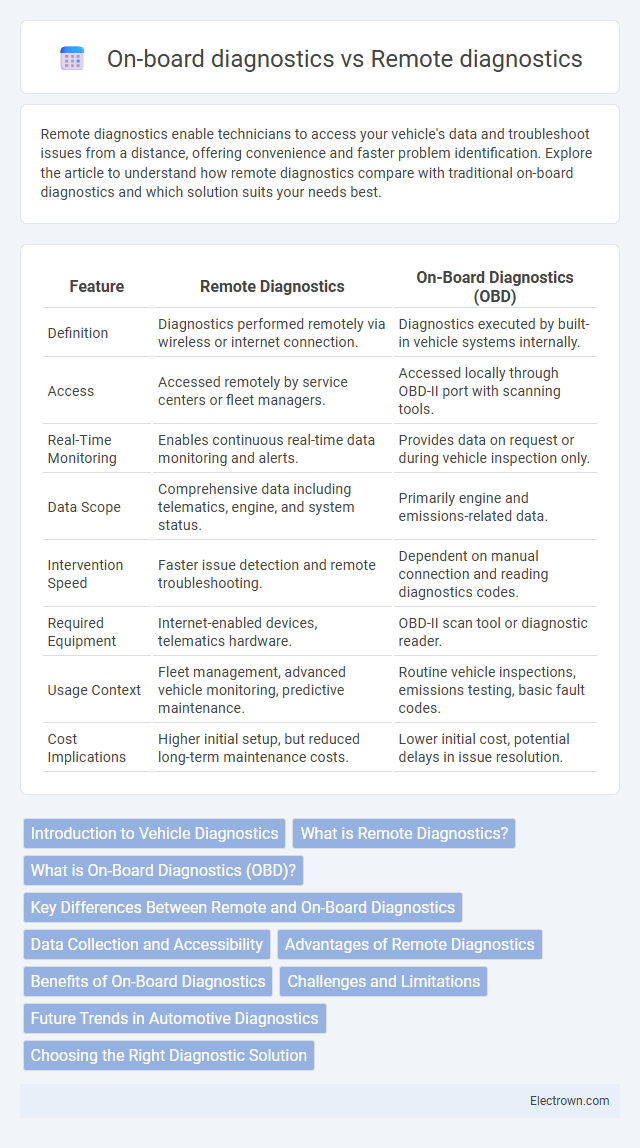Remote diagnostics enable technicians to access your vehicle's data and troubleshoot issues from a distance, offering convenience and faster problem identification. Explore the article to understand how remote diagnostics compare with traditional on-board diagnostics and which solution suits your needs best.
Table of Comparison
| Feature | Remote Diagnostics | On-Board Diagnostics (OBD) |
|---|---|---|
| Definition | Diagnostics performed remotely via wireless or internet connection. | Diagnostics executed by built-in vehicle systems internally. |
| Access | Accessed remotely by service centers or fleet managers. | Accessed locally through OBD-II port with scanning tools. |
| Real-Time Monitoring | Enables continuous real-time data monitoring and alerts. | Provides data on request or during vehicle inspection only. |
| Data Scope | Comprehensive data including telematics, engine, and system status. | Primarily engine and emissions-related data. |
| Intervention Speed | Faster issue detection and remote troubleshooting. | Dependent on manual connection and reading diagnostics codes. |
| Required Equipment | Internet-enabled devices, telematics hardware. | OBD-II scan tool or diagnostic reader. |
| Usage Context | Fleet management, advanced vehicle monitoring, predictive maintenance. | Routine vehicle inspections, emissions testing, basic fault codes. |
| Cost Implications | Higher initial setup, but reduced long-term maintenance costs. | Lower initial cost, potential delays in issue resolution. |
Introduction to Vehicle Diagnostics
Vehicle diagnostics play a critical role in maintaining automotive performance and safety by identifying issues through system analysis. Remote diagnostics leverage telematics and cloud technology to monitor real-time vehicle data, enabling proactive maintenance without physical inspection. On-board diagnostics (OBD) rely on in-vehicle sensors and standardized protocols like OBD-II to provide immediate fault codes and system status accessible via diagnostic scanners.
What is Remote Diagnostics?
Remote diagnostics involves analyzing vehicle or equipment data from a distance using telematics and internet connectivity, enabling real-time monitoring without physical access. This technology streamlines maintenance by detecting issues early, reducing downtime and repair costs. Your business benefits from faster problem resolution compared to traditional on-board diagnostics, which require direct connection to the vehicle's onboard computer.
What is On-Board Diagnostics (OBD)?
On-Board Diagnostics (OBD) is an automotive technology that monitors and reports vehicle performance and emissions data directly from the engine control unit. OBD systems provide real-time information and diagnostic trouble codes (DTCs) that help identify issues within various vehicle subsystems. Understanding your vehicle's OBD data enables precise troubleshooting and efficient maintenance, improving overall vehicle reliability.
Key Differences Between Remote and On-Board Diagnostics
Remote diagnostics enables real-time vehicle data analysis through wireless communication, allowing mechanics to identify issues without physical access to the vehicle. On-board diagnostics (OBD) systems use embedded sensors and a standardized interface to monitor engine and emissions performance directly within the vehicle. The primary difference lies in remote diagnostics' ability to provide continuous, off-site monitoring versus OBD's localized, manual scanning approach.
Data Collection and Accessibility
Remote diagnostics enables continuous data collection through wireless communication, allowing real-time monitoring of vehicle performance from any location. On-board diagnostics (OBD) systems collect data locally within the vehicle using sensors and control units, accessible primarily via physical connection or limited wireless interfaces. Remote diagnostics enhances accessibility by transmitting data to centralized platforms for instant analysis, whereas OBD data retrieval often requires proximity to the vehicle or specialized tools.
Advantages of Remote Diagnostics
Remote diagnostics offers real-time monitoring and faster issue detection compared to on-board diagnostics, enabling proactive maintenance that reduces downtime and costly repairs. Your vehicle's data is transmitted wirelessly to experts who can analyze problems remotely, ensuring quicker and more accurate troubleshooting without the need for a physical inspection. This advanced connectivity enhances fleet management efficiency and improves overall operational safety by addressing issues before they escalate.
Benefits of On-Board Diagnostics
On-Board Diagnostics (OBD) provides real-time vehicle health monitoring and immediate fault detection, enabling faster troubleshooting without needing specialized external tools. It enhances maintenance accuracy by continuously collecting data from various sensors, which helps prevent breakdowns and optimize engine performance. Your ability to access OBD data simplifies compliance with emission standards and supports timely repairs, reducing overall vehicle downtime and costs.
Challenges and Limitations
Remote diagnostics face challenges such as data security risks, limited real-time accuracy due to connectivity issues, and dependence on external networks for transmitting vehicle information. On-board diagnostics, while providing immediate and direct access to vehicle data, have limitations in data scope and the inability to offer remote monitoring or updates. Your choice between these systems depends on balancing the need for instant, localized data analysis against the convenience and broader reach of remote diagnostics.
Future Trends in Automotive Diagnostics
Future trends in automotive diagnostics emphasize the integration of remote diagnostics and on-board diagnostics (OBD) systems, enhancing real-time vehicle monitoring and predictive maintenance. Advanced telematics and IoT connectivity enable remote diagnostics to identify issues remotely, reducing downtime and improving service efficiency. Innovations in AI-driven analytics within OBD systems promise more accurate fault detection and proactive vehicle health management, shaping the next generation of automotive diagnostics.
Choosing the Right Diagnostic Solution
Choosing the right diagnostic solution depends on factors like vehicle type, real-time data needs, and budget constraints. Remote diagnostics enable proactive maintenance by transmitting data via cellular networks, offering continuous monitoring for fleet management. On-board diagnostics (OBD) provide instant, localized fault codes and vehicle status, ideal for immediate troubleshooting and repair processes.
Remote diagnostics vs On-board diagnostics Infographic

 electrown.com
electrown.com